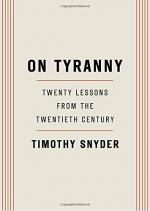|
This section contains 375 words (approx. 1 page at 400 words per page) |

|
On Tyranny: Twenty Lessons From the Twentieth Century Summary & Study Guide Description
On Tyranny: Twenty Lessons From the Twentieth Century Summary & Study Guide includes comprehensive information and analysis to help you understand the book. This study guide contains the following sections:
This detailed literature summary also contains Topics for Discussion on On Tyranny: Twenty Lessons From the Twentieth Century by Timothy Snyder.
The following version of this book was used to create this study guide: Snyder. Timothy. On Tyranny: Twenty Lessons from the Twentieth Century. Tim Duggan Books, 2017.
On Tyranny: Twenty Lessons from the Twentieth Century by Timothy Snyder is a series of historical lessons the author believes are essential for Americans to learn in order to resist the rise of tyranny in the United States. The book is predicated on the idea that the United States, despite popular opinion, is not uniquely immune to the risk of tyrannical government. It is written as a reaction to the election of President Donald Trump, whom the author criticizes extensively.
Snyder’s lessons can be grouped into five broad categories. The first is an argument against unconscious compliance and submission to tyranny. He notes that tyrants often first gain power through elections and then gradually increase their control over the political system through the tacit consent of their citizens. Secondly, Snyder addresses civil servants, arguing that their cooperation is essential for a tyranny to function thus they should refuse to obey immoral orders or facilitate the deprivation of human rights. Third, the author describes verifiable truth as the ultimate enemy of tyrants and urges the reader to seek out and support high-quality, investigative journalism. In this section, he also sharply criticizes the actions of President Trump. Next, Snyder emphasizes the importance of building relationships, both within communities and across international borders. Resisting tyranny requires collective effort and a careful study of those who have previous experience with it. Finally, the author explores the ways tyrants may manipulate their citizens into genuinely supporting their actions, most notably through the use of catastrophic events to justify a choice between freedom and safety. Throughout the book, he urges vigilance and constant involvement in the democratic process.
Snyder, a historian with extensive background in the Holocaust, makes several comparisons between Trump’s actions and those Adolf Hitler took in his early days in power. He also provides other historical examples, most notably from Poland and Czechoslovakia of successful efforts to resist tyranny. Overall, he argues that Americans need to better understand the history of Europe’s Fascist and Communist regimes to ensure that the United States. does not descend into tyranny.
Read more from the Study Guide
|
This section contains 375 words (approx. 1 page at 400 words per page) |

|



